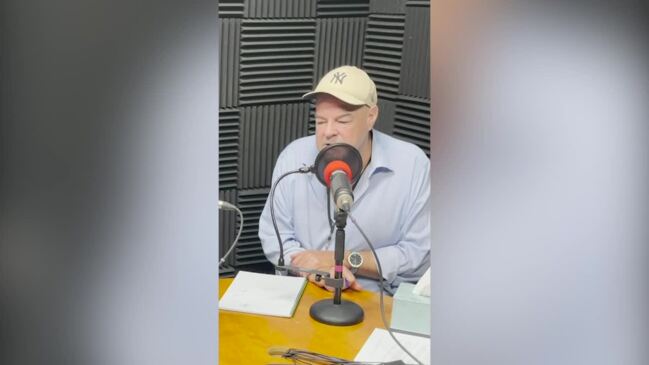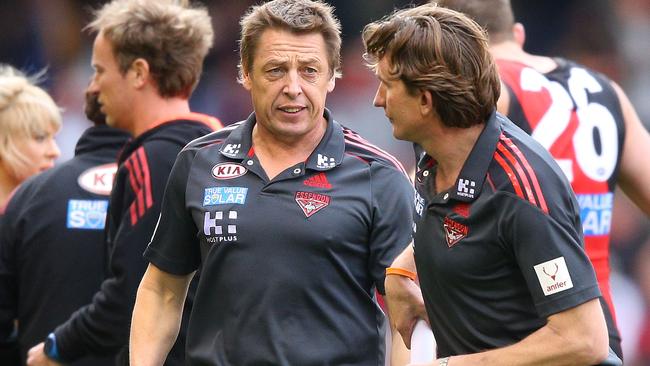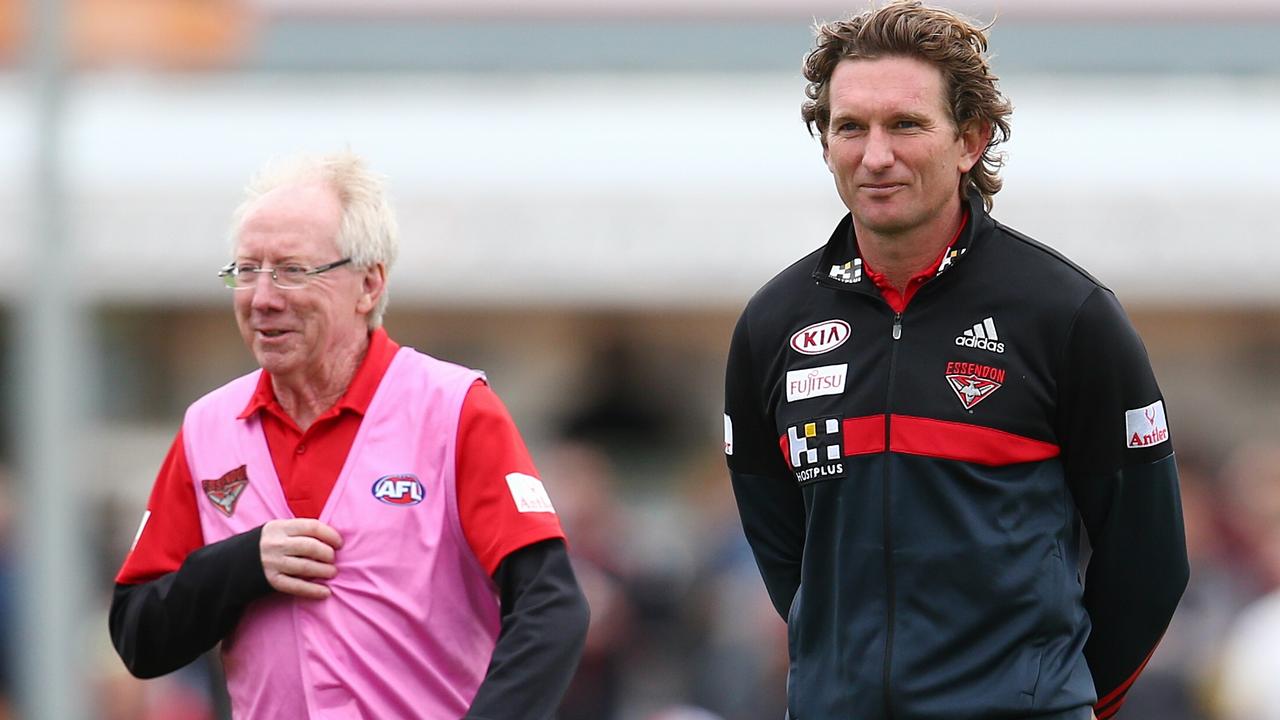Destruction of the Bombers: How the drugs saga ripped the soul out of the Essendon Football Club
It is 10 harrowing and contentious years since the destruction of the Bombers began in 2013, Mark Robinson looks at the relationships that may never recover.

AFL
Don't miss out on the headlines from AFL. Followed categories will be added to My News.
Essendon remains a ghost of warriors past.
It is 10 harrowing and contentious years since the destruction of the Bombers began, on Tuesday, February 5, 2013, when the darkest day in Australian Rules history cast allegations of drug cheating.
They proved to be correct despite no positive drugs tests, but the “strands of evidence’’ saw the world’s highest sports governing body, the Court of Arbitration for Sport, eventually bring down the gavel and declare guilty.
The never-ending saga – it’s still in dispute – brought unforgivable grief for 34 suspended players, it ripped the soul out of the football club and a once proud supporter base and ended countless friendships.
Like that of James Hird and Tim Watson, Hird and former chairman David Evans, and how premiership captain Mark Thompson lost everyone for a time there.
There are many more within the football club.
Trust was lost. Forgiveness was rare.

Forged on premierships played together, Hird and Watson don’t speak, Evans hasn’t spoken publicly since he resigned as president, and Thompson is a virtual recluse, quietly making bespoke furniture in Airport West.
“I’ve tried to maintain relationships with all of them, premiership captain, premiership champions, and it’s all broken,’’ former senior staffer Danny Corcoran lamented to the Herald Sun.
February 5, 2013, was an extraordinary day.
The press conference at AFL headquarters was tornado-like for its impact.
Evans announced the club had self-reported and, in hindsight, from that moment, the Bombers lost their ability to defend themselves.
The AFL, by virtue of the joint investigation with ASADA, became investigator and prosecutor, and by the time the interim report was delivered in August, 2013, which helped the league to boot the Bombers from the finals, Essendon was effectively doomed.
Overall, tens of millions of dollars in legal fees would be spent by the AFL, Essendon, ASADA and Hird included, in what seemed never-ending courtroom showdowns.
Hird was tenacious, adamant PEDS were not taken and even more adamant the AFL’s involvement was corrupt. But the Federal Court of Appeal would eventually end his crusade.
Still, questions remain unanswered about the regime of peptide injections.
Were they given PEDS?
CAS said yes. The AFL said yes. The AFL-fed media said yes. People at Essendon still say no.
By its tedious end, ASADA couldn’t prove they took PEDs and Essendon couldn’t prove they didn’t. But there was no stalemate. CAS played the joker and the Bombers had run out of trumps.
Stephen Dank, who previously was involved at Geelong and Gold Coast, became as notorious as Ned Kelly. He was portrayed as a mad sports scientist who convinced others that winning could be found in a needle as much as it could be found on the training track.
Only Dank really knows what he gave the players, and he says on today’s Herald Sun front page that he was set up.
Very few people will believe him, and even if what he says is true, some people still won’t want to believe him.
That’s despite the AFL’s anti-doping tribunal clearing him of doping the players after a gruelling 18-day trial. Dank maintains there is literally no evidence that the drug in question, Thymosin beta-4, had been administered to Bombers players.
There’s little point today having a forensic look at every rabbit hole which swallowed the Essendon supplement saga, suffice to say Essendon was punished by the AFL for poor governance, and Hird, Thompson and Corcoran were held up to be the masterminds.
It’s unfathomable that Hird was forced to take a 12-month suspension despite barely rating a mention in the hearings against the players, and Dean Robinson, the high performance manager who was in charge of Dank, eventually won close to a $1million payout for wrongful dismissal.

It’s also unfathomable that the three highest office holders at the club at the time, president Evans, chief executive Ian Robson and football boss Paul Hamilton have never spoken about their role during the saga.
“I know my conscience is clear,” Hamilton wrote in a text to the Herald Sun in May 2013.
Robson resigned, also in May of that year, claiming he wasn’t aware of the supplements program.
As the saga ran, it seemed that the AFL needed a scapegoat. At the end, they were Hird, Thompson and Corcoran, determined at a ‘’hearing” at AFL headquarters in 2013.
Hird received 12 months, Thompson a $30,000 fine and Corcoran a six-month suspension.
It wasn’t a hearing at all. It was the culmination of backroom deals, threats and inducements.
Indeed, the whole saga was poisoned.
Because the AFL was desperate to have the players cleared to avoid Armageddon in terms of TV rights contracts, the AFL’s strategy was to instead blame a handful of officials.
But ASADA boss Ben McDevitt had other ideas.
McDevitt, who became chief executive of the anti-doping body after the departure of Aurora Andruska, nailed the players, ending the AFL’s hopes of containing the scandal to mere governance breaches.
The saga nearly killed Hird. He was rushed to hospital with a stomach full of pills and red wine as depression and PTSD drove him to the unthinkable.
Thompson, who himself was besieged by drug dependency, always believed Evans was a puppet for Demetriou.
Days after Hird was hospitalised in 2017, Thompson wrote an email to Evans.
“I think it’s time you stepped up to be the man we thought you were,” Thompson said to Evans.

“It’s time to start fighting for the truth for all our sakes, and most importantly for the players’ sake. They deserve to know everything we know about this fiasco. It’s time we all stood up and right the wrong.
“James will die if you continue to let the world bully him. Your former best friend will die fighting for the cause ... You need to save my life and that of James Hird, Danny Corcoran, Dr Bruce Reid and 34 current and past players.
“You would save the game in many ways. It’s been a cover-up from the start. And like Watergate, the cover-up is worse than the crime.”
The much-loved Doc Reid passed away in October 2020. He had cancer. Friends wonder how much did the saga contribute to his death.
“Who knows what stress it had on Dr Reid,’’ Corcoran said.
Doc was a fighter. When he threatened to sue the league after being charged for his involvement in the supplements program, the league dropped all charges.
For a short time, even Hird and Reid, whom Hird considered a father-figure for 25 years, had a falling out. It was rectified and when Reid died of cancer, Hird was inconsolable in a New York hotel room.
The friendship between Watson and Hird right now at least is beyond repair. That’s not to say it can’t be saved, and Corcoran is endeavouring to fix what is ‘’broken’.
But it’s the coldest of cold wars between the pair.
When Hird put up his hand to coach Essendon in 2023, Watson was not a supporter.
Watson’s son Jobe, one of Essendon’s most loved players, was forced to return his Brownlow Medal, won in 2012, the year of peptide.

It was gut-wrenching for the Watson family, and although Tim doesn’t believe the players took PEDS, that his son found himself terribly let down by the club, which was coached by Hird, it’s easy to understand the dad’s agony.
He made it clear he was opposed to Hird returning to the club.
“I think for a lot of people it would drag back all those things that happened and occurred during that period of time that he was there as coach,” Watson said on SEN.
“I have to say that I’d be more than surprised if he ended up being the coach.’’
Watson is a powerful figure at Essendon and his comments, both publicly and more than likely privately, would’ve been noted by new president David Barham.
Evans remains a curious figure. He has only briefly spoken in the past decade about what occurred at Essendon, especially in the initial stages.
He and Hird fell-out in 2013 when the Herald Sun detailed a phone call between Evans and then AFL chief executive Andrew Demetriou, which culminated in Essendon self-reporting to ASADA and the AFL the next day.
Hird, Reid, Robson and Corcoran were at Evans’ house when the phone call was made.
Demetriou has denied he tipped off Evans that Essendon was the club being investigated for doping
The Herald Sun’s front page called it the “Night of Crisis”.
The next night, Evans collapsed in the rooms after a game at Marvel. The day after he resigned as chairman.
Hird and Evans were best mates. They haven’t spoken in a decade.
The drugs saga was an incredibly hostile period for everyone involved, and the scars remain, not least for the 34 players who were suspended for a year.
They did nothing wrong.
And that is the greatest shame of all.




